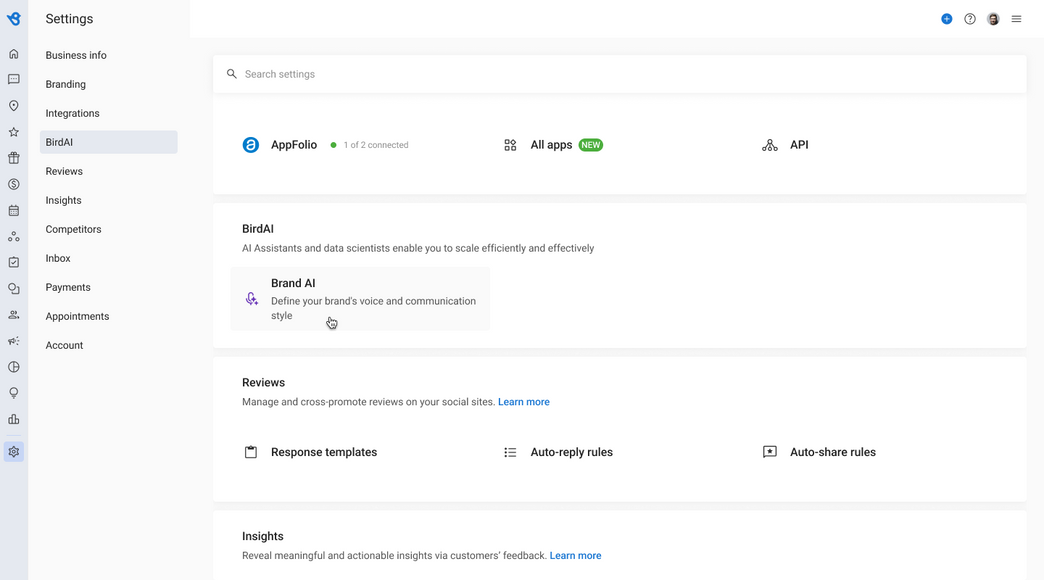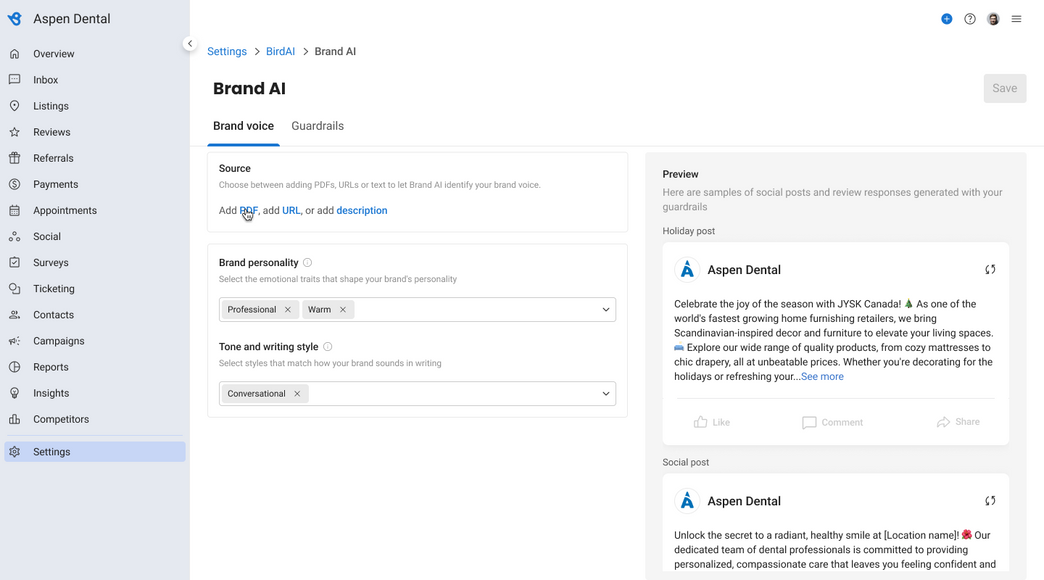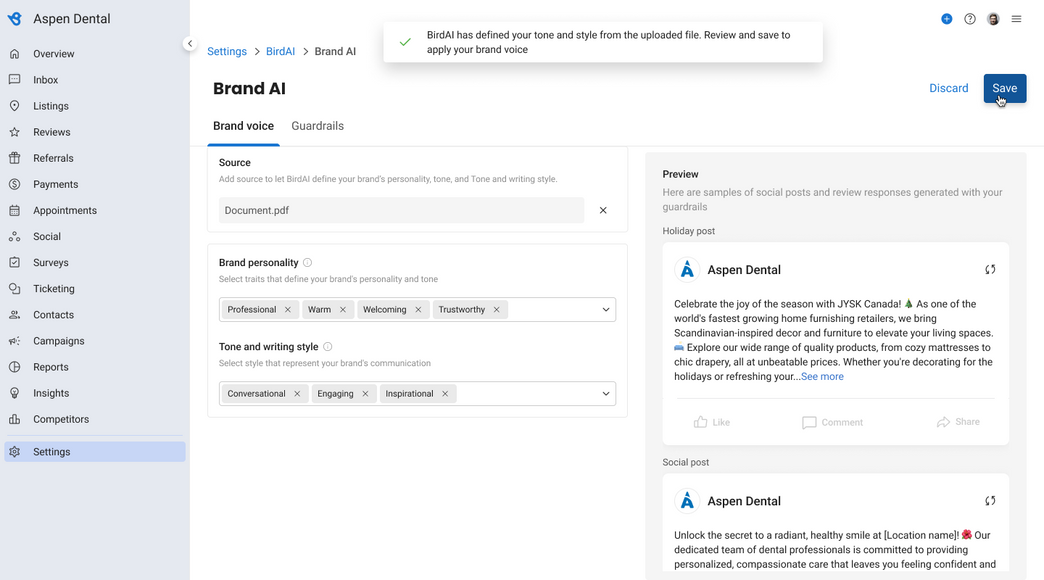BIRDEYE AI DIRECTIVES
Custom rules to guide AI responses—ensuring every interaction reflects your brand voice.


Overview
AI Directives lets Birdeye
customers guide AI-generated
responses across the platform,
ensuring consistent, on-brand
comm. across all AI touchpoints
MY ROLE
Design Lead & Project Owner
I led the overall design and development of the AI directives, ensuring smooth collaboration across teams and aligning the project with business goals.
Competitor Research & UX Designer
I conducted comprehensive competitor research to identify market gaps, and then designed intuitive user interfaces and prototypes that were tested and refined with stakeholders.
Customer-Centric Strategist
Working closely with project managers, I focused on understanding customer pain points, defining goals, and crafting solutions that addressed both user needs and business objectives.
Developer Collaborator & QA Tester
I collaborated closely with developers to address queries, conducted thorough testing of the implemented design, and ensured the final product was user-friendly and ready for launch.
PROBLEM STATEMENT

Inconsistent Brand Voice and Lack of Contextual Control:
No Guardrails for Compliance, Risk, or Content Boundaries:
Businesses struggle to maintain a unified brand identity across AI-generated content. Without the ability to define tone, writing style, and contextual behavior per use case, responses often feel generic or mismatched. For instance, the same AI tone used for social posts may sound inappropriate in a sensitive review reply. This inconsistency reduces trust, forces manual edits, and limits AI adoption across teams.
AI responses risk including off-brand, insensitive, or non-compliant language—posing legal and reputational issues. There’s currently no way to set guardrails to restrict specific terms, avoid negative phrasing, or enforce policies like HIPAA compliance. Businesses lack control to prevent risky content from being published, creating friction in trust and scalability of AI usage.

THE GOAL
-
Allow businesses to define their brand voice, tone, and writing style to generate responses that feel human, on-brand, and appropriate across all communication channels.
-
Let users configure distinct AI behavior for different content types (e.g., reviews vs. social posts) to ensure tone and language align with context and audience.
-
Provide tools to set banned keywords, sensitive phrases, and legal restrictions (e.g., HIPAA rules) to ensure AI responses remain safe, appropriate, and legally compliant.
-
Give users control over AI behavior by allowing them to upload source documents, set tone presets, and review responses before publishing.
-
Increase team confidence in using AI across departments by offering predictable, editable, and previewable responses tailored to their exact business needs.
-
Automate content creation without losing quality, brand alignment, or tone accuracy—minimizing the need for human rewrites.
STEPS
TAKEN
Research
Stakeholders Interviews
Internal teams emphasized the need for AI responses to better reflect each business’s brand tone and customer communication preferences, highlighting frequent complaints about rigid, impersonal replies.
Customer Research
Competitors offering AI personalization features (e.g., tone settings, template variety, language options) are perceived as more adaptable and customer-centric, setting a higher bar for response quality.
Competitor Analysis
Competitors offering AI personalization features (e.g., tone settings, template variety, language options) are perceived as more adaptable and customer-centric, setting a higher bar for response quality.
How might we?
Personalization & Control
How might we allow businesses to define their brand tone, voice, and writing style for AI responses?
How might we give users control over the inclusion of specific details (e.g., last names, technician names)?
How might we enable dynamic customization per feature—like using different tones for review responses vs. social posts?
Sensitivity & Tone
How might we help AI avoid inappropriate or non-compliant language (e.g., HIPAA violations or banned words)?
How might we allow businesses to define guardrails for what AI should avoid or always include?
Context Awareness
How might we make AI responses reflect customer sentiment by echoing positive words from the original review?
How might we help AI decide when and what to auto-share based on the quality or type of review?



DIRECTIONAL MOCKUPS
In this ideation phase, we translated early ideas into low to mid-fidelity mockups to visualize potential solutions. These mockups helped us explore key user flows, test various scenarios across the customer journey, and evaluate how well the proposed features addressed personalization, tone, and contextual AI behavior. This phase set the foundation for refining the experience through feedback and iteration.
PROTOTYPING & testing

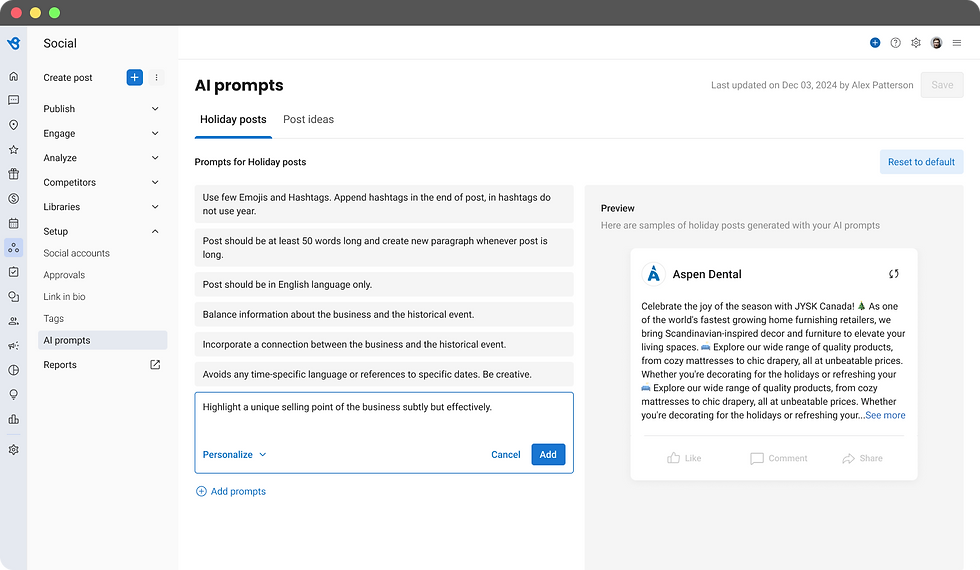
In this phase, we transformed the refined ideas from the directional mockups into high-fidelity prototypes covering key user flows. These interactive prototypes incorporated the initial feedback and helped bring the experience closer to a real product.
We conducted usability testing sessions with both stakeholders and customers to validate design decisions, identify areas of improvement, and ensure the interface aligned with user expectations. The feedback received was instrumental in refining the product experience before handing it off for development.
NOW LET'S HAVE A LOOK AT THE DESIGNS
DEFINE YOUR BRAND TONE & PERSONALITY
Upload brand documents • Link blogs or website content • Set writing style preferences • Centralized tone control • AI voice consistency



PREVIEW AI RESPONSES WHILE DEFINING BRAND STYLE
Real-time AI preview • Instant feedback loop • Visualize AI-generated replies
DEFINE GUARDRAILS TO GUIDE AI BEHAVIOR
Set response boundaries • Restrict sensitive language • Avoid specific words • Ensure HIPAA compliance • Control unwanted AI output
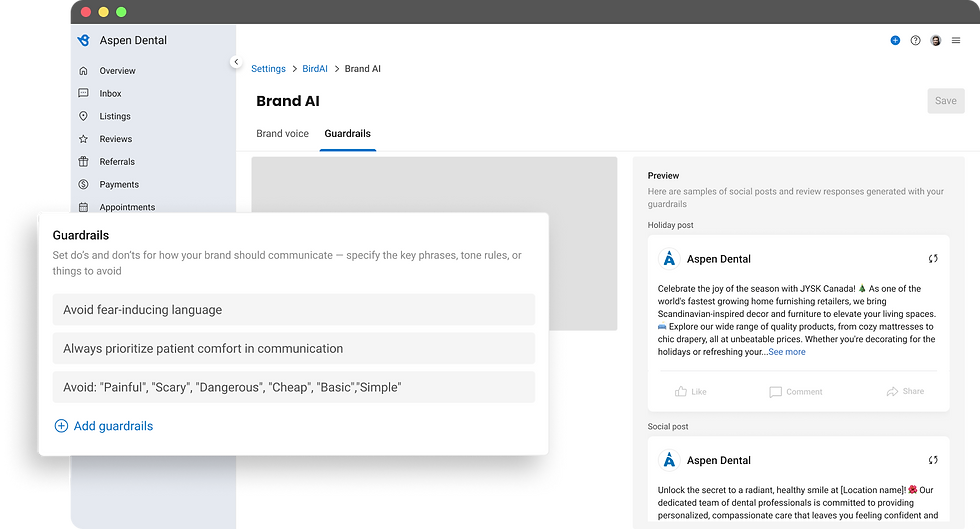


CUSTOM INSTRUCTIONS FOR EVERY FEATURE
Feature-specific AI guidance • Tailored response rules • Consistent output across tools • Flexible instructions • Granular AI control
Define Brand voice flow

IMPACT
By giving businesses control over AI-generated communication, Birdeye empowers them to stay on-brand, create personalized connections, and deliver empathetic responses. This leads to improved customer satisfaction, higher engagement rates, and more trust in the brand.
✅ On-brand messaging ensures every AI interaction aligns with the company’s tone, boosting brand consistency.
✅ Personalized responses using CRM data create human-like experiences that strengthen relationships.
✅ Empathetic communication helps businesses respond to sensitive issues with care, improving CSAT and loyalty.
For Birdeye, this results in increased product adoption, deeper customer trust in AI features, and a competitive edge in the AI communication space.
THANK YOU FOR COMING ALONG ON THIS JOURNEY.
